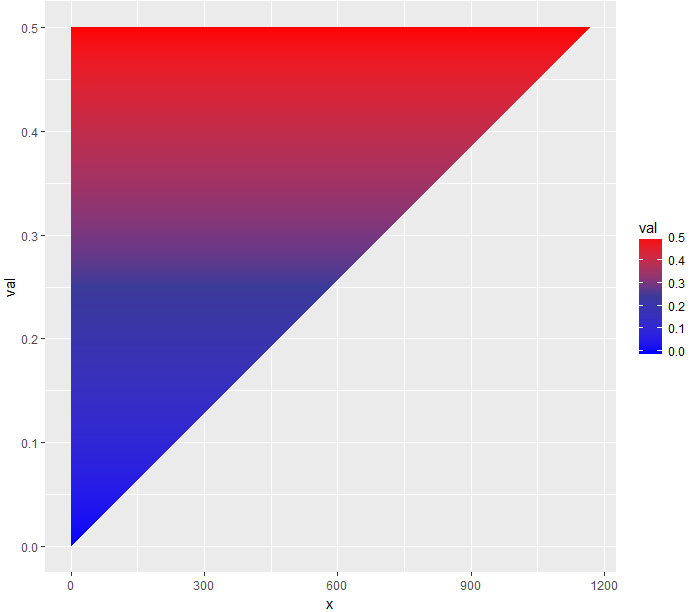The following code will do it (but horizontally):
library(scales) # for muted
ggplot(df22, aes(x = x, y = val)) +
geom_ribbon(aes(ymax = val, ymin = 0, group = type)) +
geom_col(aes(fill = val)) +
scale_fill_gradient2(position="bottom" , low = "blue", mid = muted("blue"), high = "red",
midpoint = median(df22$val))
![Ribbon-Horizontally]()
If you want to make it vertically, you may flip the coordinates using coord_flip() upside down.
ggplot(df22, aes(x = val, y = x)) +
geom_ribbon(aes(ymax = val, ymin = 0)) +
coord_flip() +
geom_col(aes(fill = val)) +
scale_fill_gradient2(position="bottom" , low = "blue", mid = muted("blue"), high = "red",
midpoint = median(df22$val))
![Ribbon-Vertically]()
Or, if you want it to be horizontal with a vertical gradient (as you requested), you might need to go around it by playing with your data and using the geom_segment() instead of geom_ribbon(), like the following:
vals <- lapply(df22$val, function(y) seq(0, y, by = 0.001))
y <- unlist(vals)
mid <- rep(df22$x, lengths(vals))
d2 <- data.frame(x = mid - 1, xend = mid + 1, y = y, yend = y)
ggplot(data = d2, aes(x = x, xend = xend, y = y, yend = yend, color = y)) +
geom_segment(size = 1) +
scale_color_gradient2(low = "blue", mid = muted("blue"), high = "red", midpoint = median(d2$y))
This will give you the following:
![enter image description here]()
Hope you find it helpful.





scale_gradientis made for mapping data to different colors. You don't have data corresponding to the different colors. There are hacky work-arounds (possible dupes), e.g. How to produce a gradient fill within a polygon? and How to make a gradient color filled timeseries plot? – Reorder